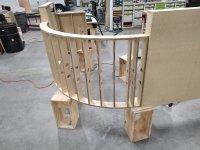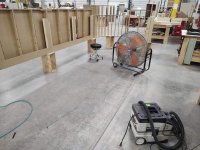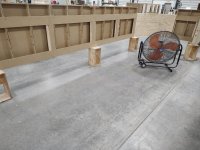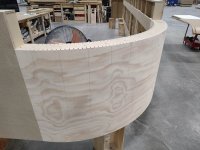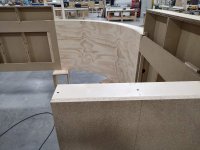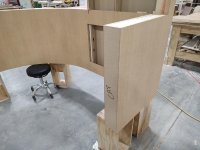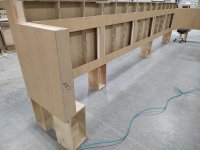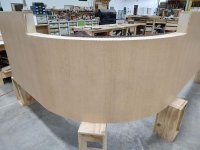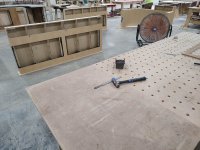Crazyraceguy
Member
- Joined
- Oct 16, 2015
- Messages
- 5,519
This particular hospital has a style (aesthetic) that they maintain with new construction and remodels.
Around here, most of them do, but they change it every decade or so. I assume this is to make refreshments more obvious? or to not appear stale, after a suitable time period? Sometimes different wings or departments vary slightly, remaining cohesive, but not exactly the same.
The recuring theme with this one is Glacier White Corian counter tops and vertical woodgrain panels.
Sometimes they are solid Oak butcherblock panels, others are just laminate (HPL) The white ties them all together though.
I got the frame built on Wednesday morning and got shifted onto another project at noon. Restarted on Thursday, getting stopped again by plywood. All we have had in stock, for the last few weeks, has been this Asian Birch. It's ok for most things, as a "shop ply", but since it is technically a veneer product, the show layers are the typical extremely thin. This does not work well for kerf-bending. The outer layer has to run the opposite direction of the desired curve. It is the part being bent, while everything below it is cut through. That super thin veneer skin cannot hold the rest of the pieces together, even when kerfed shallower, since the second layer is running parallel to the bend. It just splits and falls apart.
The Radiata pine ply came in Friday morning, so the whole unit is down to final laminating.
My helper/apprentice finished what he was doing late in the afternoon, so he may get started on this Monday.
He may also get with the Solid surface guys and test-fit the top into this unit. I'll find out Tuesday morning, I guess.
Around here, most of them do, but they change it every decade or so. I assume this is to make refreshments more obvious? or to not appear stale, after a suitable time period? Sometimes different wings or departments vary slightly, remaining cohesive, but not exactly the same.
The recuring theme with this one is Glacier White Corian counter tops and vertical woodgrain panels.
Sometimes they are solid Oak butcherblock panels, others are just laminate (HPL) The white ties them all together though.
I got the frame built on Wednesday morning and got shifted onto another project at noon. Restarted on Thursday, getting stopped again by plywood. All we have had in stock, for the last few weeks, has been this Asian Birch. It's ok for most things, as a "shop ply", but since it is technically a veneer product, the show layers are the typical extremely thin. This does not work well for kerf-bending. The outer layer has to run the opposite direction of the desired curve. It is the part being bent, while everything below it is cut through. That super thin veneer skin cannot hold the rest of the pieces together, even when kerfed shallower, since the second layer is running parallel to the bend. It just splits and falls apart.
The Radiata pine ply came in Friday morning, so the whole unit is down to final laminating.
My helper/apprentice finished what he was doing late in the afternoon, so he may get started on this Monday.
He may also get with the Solid surface guys and test-fit the top into this unit. I'll find out Tuesday morning, I guess.

